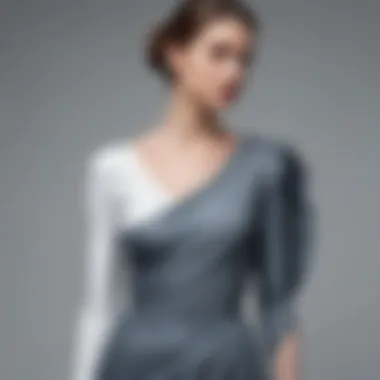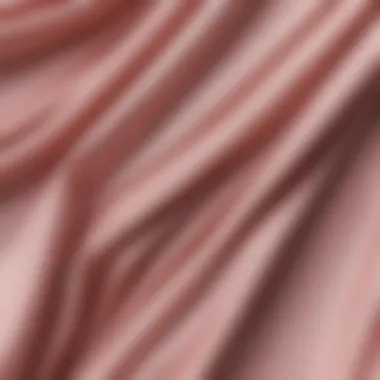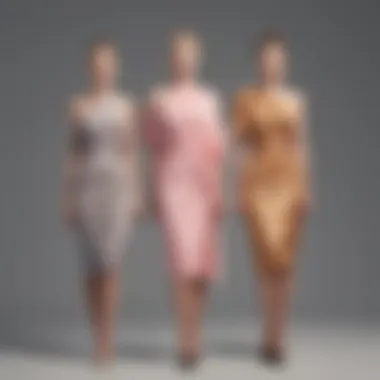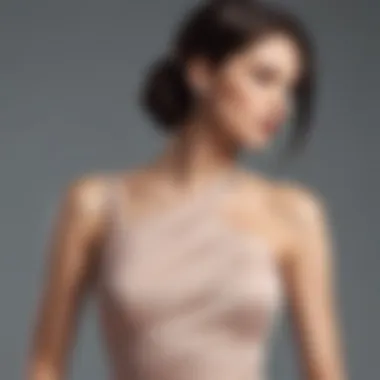Exploring the One Sleeve Asymmetrical Dress: A Study in Modern Fashion


Intro
The one sleeve asymmetrical dress isn’t merely a garment; it represents a bold statement in today’s fashion landscape. While this style might seem modern, its roots run deep in history, intertwining with various cultural movements and individual expressions. This dress encapsulates an enticing blend of femininity and edginess, captivating fashion enthusiasts, shoppers, and stylists alike. With a daring silhouette that draws the eye, it has become a favored choice for special occasions, informally and formally alike.
Understanding this dress goes beyond aesthetics; it involves an exploration of its historical context and cultural significance. From the elaborate gowns of ancient civilizations to modern red-carpet moments, the journey of this dress style showcases evolution and versatility. In the following sections, we will delve into current trends and practical style tips that elevate the one sleeve asymmetrical dress into an essential garment for anyone looking to refine their wardrobe.
Fashion Trends
Current Trends in Clothing
In the realm of fashion, trends shift with the seasons, yet the one sleeve asymmetrical dress remains a steadfast favorite. Its adaptability means it can be dressed up for evening events or made casual for daytime brunches. Recently, this style has transitioned into various fabric choices, ranges from sleek satin to textured cotton blends, making it suitable for a plethora of occasions.
A few notable trends include:
- Bold Patterns and Colors: Bright florals, geometric prints, and earth tones dominate this season.
- Layering Techniques: Many are pairing these dresses with fitted turtlenecks or oversized jackets, especially during cooler months.
- Sustainable Fabrics: The trend toward eco-friendliness means many opt for dresses made from organic cotton or recycled materials.
Seasonal Attire Suggestions
When selecting a one sleeve asymmetrical dress for different seasons, keeping the climate and occasion in mind is vital.
- Spring and Summer: Opt for light, breathable fabrics with floral patterns or pastel shades. Accessories can include sandals and delicate jewelry.
- Fall and Winter: Darker tones and heavier fabrics, such as velvet or knit, pair beautifully with boots and structured outerwear, instantly elevating the look.
Style Tips
How to Mix and Match Outfits
The versatility of the one sleeve asymmetrical dress allows for countless styling possibilities.
- Layering: For a sophisticated nod, layer a fitted turtleneck under the dress and complete the look with knee-high boots.
- Accessorizing: Choose statement earrings or a bold cuff bracelet to draw attention to the unique neckline.
- Footwear Variety: Experiment with stilettos for elegance, or switch to ankle boots for an edgier vibe.
Essential Wardrobe Staples
Incorporating this dress into your wardrobe calls for a thoughtful selection of base items that enhance its appeal. Some essentials include:
- A classic leather jacket to add a bit of edge.
- A well-fitted pair of black trousers for a layered look.
- Versatile ankle boots that can transition between fancy and casual settings.
Intro to the One Sleeve Asymmetrical Dress
The one sleeve asymmetrical dress represents a significant element in contemporary fashion, merging style with intriguing structural design. Its distinctive features turn heads and elevate the wearer's presence at any event. Understanding this dress is like peering into the very heart of modern aesthetics, which value individuality and creative expression. In recent years, fashion enthusiasts have embraced this unique silhouette for its versatility and the statement it makes. As we delve into the nuances of this garment, we see it holds a mirror to changing societal norms, offering an opportunity for personal style articulation.
Defining the Garment
At its core, the one sleeve asymmetrical dress is characterized by its single sleeve design that sets it apart from traditional dresses. This creates an unbalanced elegance, providing an edgy twist that merges comfort with style. The asymmetrical hemline, paired with the rambling of fabric across the body, enhances visual interest while showcasing the wearer's figure beautifully. It straddles the line between casual and formal, making it ideal for a range of occasions. Each design choice in this garment is intentional, emphasizing the wearer's individuality and taste.
Historical Background
Evolution through the Decades
The one sleeve asymmetrical dress has a rich history, evolving significantly from the 1960s to the present day. Initially, it burst onto the fashion scene as a bold risk-taker's choice, contrasting sharply with the symmetry that dominated earlier design trends. By the time the 1970s rolled around, designers began experimenting with cutting-edge styles, allowing more vibrant colors and patterns. This evolution highlights fashion's ongoing journey of risk and reward, pulling designers forward while enticing wearers to be bold. Over the decades, the dress has morphed, finding a comfortable spot in both high fashion and ready-to-wear collections, which speaks to its enduring appeal.
Cultural Influences in Fashion


Cultural factors play a pivotal role in shaping the one sleeve asymmetrical dress. Woven into the fabric of fashion history, it reflects shifting attitudes toward femininity and self-expression. From the influence of Hollywood starlets to cultural icons, the dress embodies a sense of empowerment. Designers like Azzedine Alaïa and Oscar de la Renta have embraced the asymmetrical look, showcasing it as a canvas for their creative visions. Its popularity stems from the ability to channel diverse cultural narratives to suit an individual’s expression, presenting endless possibilities while keeping the traditional elements intact.
The Dress in Pop Culture
Iconic Appearances on Red Carpets
The allure of the one sleeve asymmetrical dress often shines brightest on the red carpet. Celebrities sport this garment, making bold fashion statements that capture the public imaginations. From Beyoncé dazzling in a sleek black design to Sarah Jessica Parker turning heads with a colorful number, these appearances underscore the dress's potential to dazzle. The strategic use of asymmetry can elevate a star’s style while keeping attention on their personal brand. It reveals how this dress has cemented itself as a staple for those who wish to be remembered long after the cameras stop flashing.
Representation in Media and Art
In the landscape of media and art, the one sleeve asymmetrical dress continues to resonate. Its compelling lines and forms have inspired many photographers and visual artists, translating its aesthetics into diverse interpretations. The pattern of portraying this dress in various artistic expressions suggests a deeper cultural significance; it speaks of freedom and breaks away from societal norms. As a subject of portrayal, it invites conversation and critique around fashion and identity, bridging gaps between the artistic and practical realms.
Design Elements of the One Sleeve Asymmetrical Dress
The design elements of the one sleeve asymmetrical dress play a crucial role in defining its aesthetic and functionality. These elements not only contribute to the dress’s visual appeal but also impact how it can be worn and styled across various occasions. Understanding components like cut, fabric, and color choice enhances the overall appreciation of the dress and allows for more informed fashion decisions.
Cut and Structure
A-Line vs. Fitted Silhouettes
Choosing between an A-Line and a fitted silhouette can make all the difference in how the dress conveys a sense of style. The A-Line style flares out gently from the waist, creating a soft and flattering look that works well for many body types. This silhouette gives an elegant flow to the dress, allowing for comfortable movement while enhancing the waistline. A lot of folks appreciate this cut for its versatility; it can transition from day to night with ease.
On the flip side, the fitted silhouette clings closely to the body, accentuating curves and providing a more structured appearance. This form tends to convey a more formal vibe, making it suitable for events where one needs to stand out. A fitted style can leverage the asymmetrical design effectively, drawing attention to the unique cut of the dress. However, one must consider body type — while fitted dresses can be very appealing, they may not suit everyone, especially those who are uncomfortable with snug garments.
Length Variations
When discussing length variations, the options can significantly influence an outfit's overall essence. A floor-length asymmetrical dress offers a dramatic flair and can exude a sense of sophistication. It’s often showcased in formal events, drawing the eye up and down, thereby elongating the figure. On the other hand, shorter lengths can lend a playful, youthful feel. Mid-thigh or knee-length dresses provide a playful yet chic touch, making them perfect for social gatherings or outings.
The key takeaway here is choosing the length that represents personal style, as well as the context of the occasion. A longer length often speaks to elegance and grandeur, while shorter lengths can convey a casual yet fashionable edge. Each choice comes with its pros and cons, often influenced by comfort level and body confidence factors.
Fabric Selections
Silk and Satin Choices
Silk and satin choices are paramount in elevating the sophistication of a one sleeve asymmetrical dress. Both fabrics have a natural luster and smooth texture which enhance the garment's allure. Silk, known for its breathability and luxurious feel, drapes beautifully, allowing for graceful movement. Additionally, it provides a soft touch against the skin, making it a popular choice for evening wear.
Satin, while similar, has a more shiny finish and is often crafted from synthetic fibers, making it slightly more durable. This fabric can handle intricate draping and detailing, adding a modern touch to the classic silhouette. In terms of care, satin may require a bit more attention during washing, while silk generally demands a gentler approach.
In the grand scheme, both materials offer unique characteristics that can fit different occasions and preferences. However, buyers should weigh the aspect of maintenance and comfort against the dress's intended use.
Opting for Casual Versus Formal Fabrics
Understanding the distinction between casual and formal fabrics is vital for appropriate styling of the one sleeve asymmetrical dress. Casual fabrics, like jersey or cotton blends, provide comfort and flexibility, making them suitable for low-key events like brunch with friends or a day at the park. These materials tend to be more forgiving and easier to care for, which is often appreciated in day-to-day wear.
In contrast, fabrics such as velvet or chiffon are often favored for formal occasions. These materials not only drape gracefully but also infuse a sense of luxury and elegance. A dress made from velvet, for example, becomes the centerpiece of any evening event, reflecting light beautifully. Yet, one must factor in the expected occasion and setting before making a final choice of fabric.
Color Dynamics
Solid Colors and Patterns
When diving into the realm of color, one can’t overlook the impact of solid colors versus patterns. Solid colors offer a timeless and classic look, often bringing out the essential form of the asymmetrical design. A deep emerald or rich burgundy, for instance, can provide a sophisticated allure, making the dress a statement piece without overwhelming the viewer.


However, patterns can add an adventurous twist to the ensemble. Floral prints or geometric designs can create a fun and modern vibe, showcasing personality through vibrant visuals. That said, while patterns can be eye-catching, it’s important to ensure they do not clash with the unique cut of the dress — a delicate balance is essential here.
Seasonal Color Trends
Keeping an eye on seasonal color trends can serve as a guiding compass when selecting a dress. Colors often change with the seasons, not only reflecting nature but also the prevailing mood of fashion trends. Warmer tones like rust and gold are typical in autumn, invoking a cozy and inviting sentiment. Meanwhile, pastels often reign supreme in spring, evoking a fresh, rejuvenating feeling.
Incorporating these colors can help the asymmetrical dress feel timely and contextually appropriate. It’s a way to make a statement while adhering to current trends, showing a keen awareness of fashion dynamics. Yet, one must also consider personal preference and what resonates most with their style; after all, individual expression is a key component of fashion.
Styling the Asymmetrical Dress
When it comes to wearing a one sleeve asymmetrical dress, how you style it can make all the difference. This garment is a statement piece, and choosing the right accessories and layering techniques can amplify its unique characteristics. Fashion enthusiasts often seek to express personal style, and the asymmetrical dress provides ample opportunity for that—making styling an essential aspect of the overall look and feel.
Choosing the Right Accessories
Footwear Pairings
Selecting the right footwear can either elevate or detract from the stunning appeal of an asymmetrical dress. High heels, for instance, bring a certain elegance, elongating the legs and enhancing the dress's silhouette. Strappy sandals in a vibrant color can add a fun touch, while classic pumps suit a more formal occasion. On the flip side, flats or sneakers can bring a casual flair, making them a savvy choice for daytime events. Paying attention to the heel height and style is crucial:
- Key Characteristic: The balance between comfort and style.
- Why It's Beneficial: Tailored footwear pairs well with asymmetrical cuts, ensuring that the dress remains the focal point of the outfit.
- Unique Features: The ability of shoes to transform the overall vibe—from sophisticated to relaxed—provides versatility across various settings.
That said, it’s also important to think about color coordination and how your choice interacts with the dress.
Jewelry and Bags
Accessories like jewelry and bags play a pivotal role in completing the ensemble. Statement earrings can showcase the one-sleeve feature of the dress while being bold enough to stand out. A delicate bracelet or a chic ring can round off the look while keeping it balanced. As for bags, opting for a clutch often aligns with the dress's formal nature, whereas a cross-body bag can lend a more laid-back feel.
- Key Characteristic: Complementing the dress without overwhelming it.
- Why It's Beneficial: Well-chosen accessories serve to enhance the dress's strong asymmetry, making the wearer appear poised and polished.
- Unique Feature: Choosing accessories with similar tones or complementary colors creates harmony, making the overall ensemble visually appealing.
Layering Techniques
Outerwear Options
Layering adds depth to the asymmetrical dress, particularly in cooler weather. A tailored blazer can add sharpness while keeping the ensemble sophisticated. Alternatively, a denim jacket infuses a bit of casual ease, making it suitable for brunch meets. Materials matter here; lighter fabrics keep the layering stylish instead of bulky.
- Key Characteristic: Enhancing warmth without sacrificing style.
- Why It's Beneficial: The right outerwear can transition a dress from day to night effortlessly.
- Unique Feature: Layering does not just provide practicality; it allows for creative expression through mixing textures and colors, which can customize the appearance.
Styling with Tights or Leggings
As the seasons shift, styling with tights or leggings presents another option. For colder days, opaque tights can seamlessly blend into the look, allowing for comfort while keeping the sartorial aesthetic intact. On the other hand, leggings can be a fun twist, bringing a fresh, modern vibe to an otherwise formal outfit.
- Key Characteristic: A balance of comfort and styling.
- Why It’s Beneficial: They allow for extended wear of the dress across various seasons, making it a versatile addition to anyone's wardrobe.
- Unique Feature: Mixing patterns, like pairing a patterned legging with a solid dress, can create unexpected visual intrigue.
Body Type Considerations
Flattering Cuts for Different Shapes
Understanding one’s body type can greatly enhance how the asymmetrical dress is worn. Various cuts can complement different shapes. For instance, those with curvier figures might favor A-line styles that flow at the hem, while someone with a straighter shape might appreciate fitted elements that highlight their figure.
- Key Characteristic: Personalizing the fit to complement individual body shape.
- Why It's Beneficial: Wearing a dress that flatters one’s body enhances confidence and exudes style simultaneously.
- Unique Feature: Different cuts can create balanced proportions, making them look more visually appealing.
Balancing Proportions


Ultimately, the idea is to create a look that draws attention while also balancing the proportions. If one side of the dress is significantly fuller, pairing it with a slim silhouette on the bottom, such as skinny jeans or fitted trousers, is a smart move.
- Key Characteristic: Harmonizing the full aspect of the dress with the overall silhouette.
- Why It's Beneficial: This approach ensures a balanced and aesthetically pleasing appearance, preventing overwhelming any single feature.
- Unique Feature: Balancing can also allow one to highlight their favorite features while minimizing others, an aspect many wearers seek to master.
Occasions to Wear a One Sleeve Asymmetrical Dress
The beauty of the one sleeve asymmetrical dress lies not just in its striking design but also in its versatility across various occasions. This article section aims to showcase how this unique garment can transcend event categories, providing a fashionable solution for dressing up or down. It allows individuals to express their personal style while also adhering to the context of each occasion, making it a garment worth exploring for any fashion enthusiast, shopper, or stylist.
Formal Events
Wedding Guests Attire
When it comes to wedding guest attire, the one sleeve asymmetrical dress offers an appealing blend of elegance and modernity. The key characteristic of this dress is its ability to balance sophistication with a sense of allure. A wedding is about celebration, and wearing such a dress can turn heads and inspire conversations. Its unique feature lies in how it highlights one shoulder while draping gracefully over the other, creating a striking silhouette.
These dresses often come in flowing fabrics such as chiffon or silk, which add an air of romance that is ideal for weddings. However, one must be cautious about the dress's fit and fabric choice to ensure it aligns with the wedding theme. Soft pastel tones or floral patterns are generally favored, but bold colors can also make a statement. The main advantage here is the way this dress allows you to move freely and comfortably while maintaining a sophisticated appearance.
Evening Gala Looks
The allure of the one sleeve asymmetrical dress truly shines during evening galas. The captivating nature of the design is perfect for events that call for high fashion. A critical feature to note is its ability to stand alone without overpowering other elements, such as accessories or makeup. This simplicity, combined with elegance, makes it a popular choice. Typically crafted from luxurious fabrics such as satin or velvet, these dresses can elevate one's overall look to new heights. Their unique feature includes structured elements like draped skirts or ruffled hems that add depth and dimension. An advantage of wearing such a dress is the ease of transitioning from standing to dancing, providing both comfort and style throughout the evening.
Casual Outings
Brunch with Friends
For a relaxed brunch with friends, the one sleeve asymmetrical dress can strike a perfect balance between casual and chic. A key advantage of this dress in such settings is that it requires minimal effort for styling while still making a statement. These dresses often come in lightweight fabrics like cotton or jersey, making them suitable for spring or summer outings. The unique feature lies in its adaptability – pair it with sandals for a laid-back vibe or dress it up with wedges for a hint of sophistication. This flexibility is what makes it a beneficial choice for those who want their wardrobe to work efficiently. Systems of contrast in color or prints can play a significant role here, lending an artful touch to the ensemble.
Daytime Events
Beyond brunch, the one sleeve asymmetrical dress is fitting for various daytime events, such as gallery openings or outdoor festivals. The most significant characteristic here is its versatile style, allowing one to blend effortlessly into different social settings. With vibrant colors or creative patterns, the dress can be both playful and stylish, a rare combination that is hard to achieve. Its unique feature is often its flirtier length that can go from knee- to ankle-length depending on the fabric and how one chooses to style it. This dress also allows for easy layering, which adds practical value for those uncertain about changing weather conditions. It can be beneficial, yet one must remain conscious of fabric weight to avoid being too formal or too casual.
Work Appropriateness
Dressing it Down for the Office
While a one sleeve asymmetrical dress might appear too flamboyant for the office, it can be dressed down with careful styling choices. A crucial characteristic is its ability to blend professional aesthetics with personal flair. Opting for a more muted color palette transforms this dress into an office staple without sacrificing personal style. Pairing it with tailored blazers or cardigans adds a professional touch, keeping it sophisticated. The unique advantage of a structured sleeveless design is that it frames the upper body beautifully while providing the freedom to move. However, one must be cautious to maintain a balance; accessories should remain understated for this setting.
Smart-Casual Combinations
Smart-casual combinations are an ongoing trend in contemporary office wear, and the one sleeve asymmetrical dress fits the bill perfectly. Its defining feature is the ability to convey both authority and approachability, making it suitable for meetings or client lunches.
The cheeky yet stylish nature of such dresses allows individuals to express their unique personality while maintaining professionalism. By pairing the dress with ankle boots or simple pumps and a sleek handbag, it can easily transition from work to after-work events. The key benefit is the freedom to express style without stepping over into overly casual territory.
In summary, whether you're preparing for a formal event, a casual outing, or looking to blend in at work, the one sleeve asymmetrical dress proves to be a versatile garment. It cleverly provides options for tailoring your look to various occasions while always keeping you stylish and confident.
The End: Embracing the Asymmetry
In the ever-evolving world of fashion, the one sleeve asymmetrical dress stands as a testament to creativity and individuality. This unique garment not only breaks conventional fashion norms but also encourages wearers to express their personal style. Embracing asymmetry means embracing variety, and the choices the one sleeve dress offers embody that notion.
Personal Style Expression
Each dress varies in cut, fabric, and color, providing an endless canvas for individual expression. A wearer can channel their inner artist by mixing pieces that reflect their personality, be it bold and colorful or soft and understated. The asymmetrical design invites a more personalized approach to styling. One can play with accessories to enhance the aesthetic; for instance, throwing on a chunky necklace or opting for minimalist studs can completely transform the vibe of the look. Additionally, layering can add yet another dimension without compromising on comfort or practicality. The beauty lies in experimentation; every stacked bracelet or contrasting belt adds personal nuances that tell a story unique to the wearer.
Future Trends
As the fashion industry continuously recycles and reinvents styles, the future for the one sleeve asymmetrical dress looks promising.
Predicted Evolution of Asymmetry in Fashion
Anticipating where fashion trends head can be tricky, yet the tendency towards asymmetry seems to be gaining traction. Designers are increasingly embracing irregular hems, angled cuts, and unexpected features beyond just one sleeve. With advancements in fabric technology, the movement incorporates more sustainability and eco-conscious materials. Not only does this contribute to a greener future, but it also provides a flexibility that can adapt to body shapes and personal preferences quite graciously.
Asymmetrical designs offer a fresh perspective, breaking the monotony of traditional silhouettes. They serve as an open door to creativity, lending themselves to a mix-and-match approach that allows for a broader range of expression.
This evolution highlights the versatility of asymmetrical pieces, making them not just for special occasions but suitable for everyday wear. The unique flair of these dresses enables them to seamlessly transition from casual to formal, enhancing their practicality in modern wardrobes. Additionally, incorporating vibrant colors and innovative textures ensures that each piece stands out in any setting, thus aligning with the fashion-forward mentality of today.















